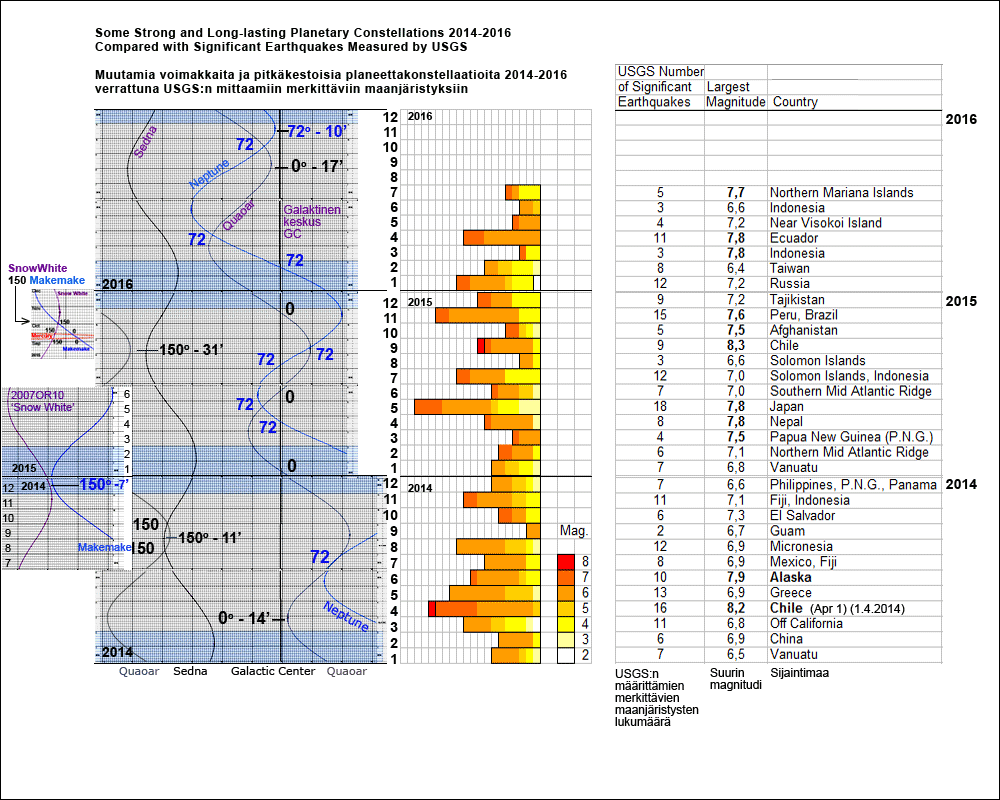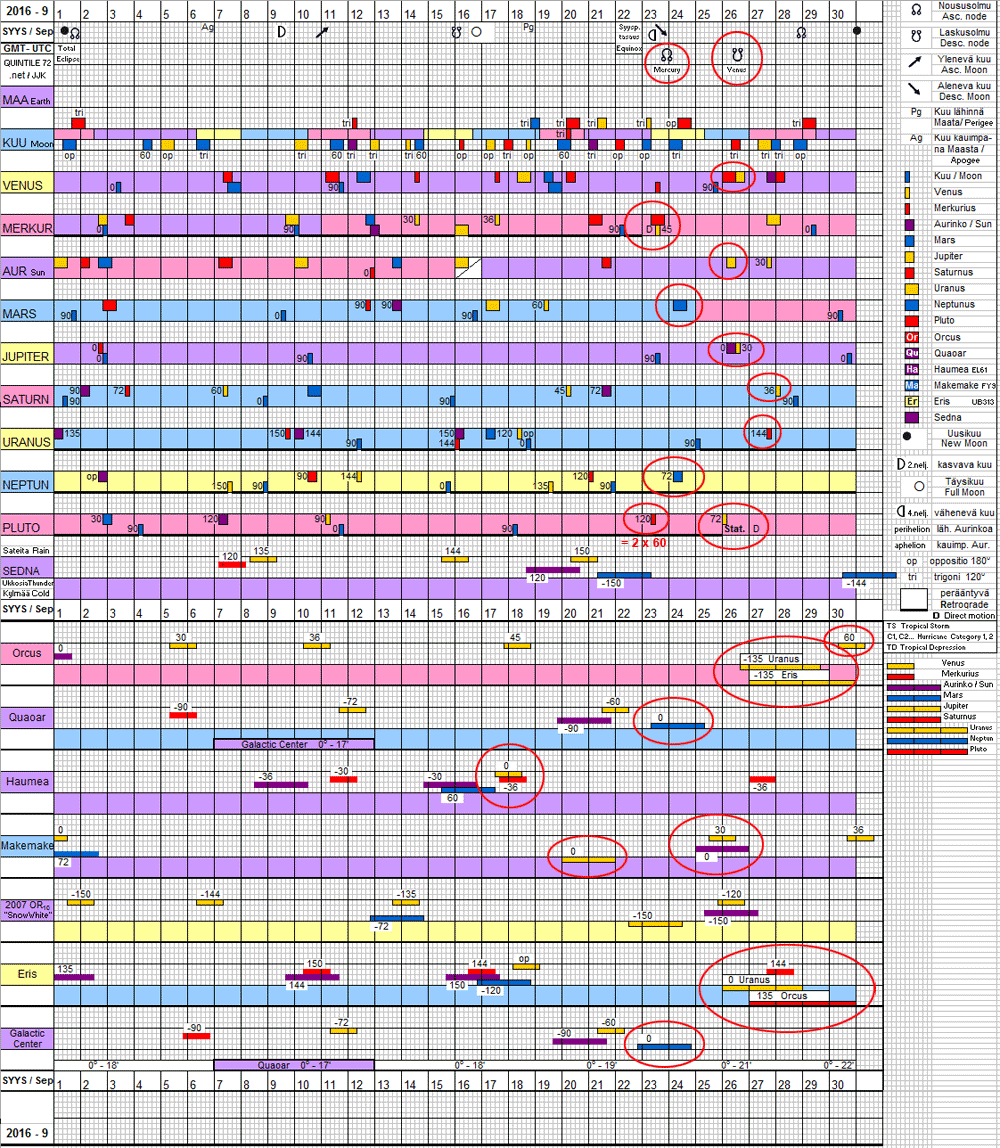|
September 2016 and the autumn as a whole contain cosmic factors that may have various effects on both the weather and the Earth's crust, and
thus deserve a closer look.
Between the 7th and the 12th of September the near-conjuction between the dwarf planet Quaoar and the Galactic Centre is at its closest point,
and only 17 arcminutes away from a full conjunction. (See the chart on the right and the lower half of the
September Weather Score.)
This constellation is comparable to the situation in late March - early April in 2014, when Quaoar moved closer to the Galactic Centre, which
it is now once again moving away from. The near-conjunction at that time fell 14 arcminutes short of a full conjunction, the corresponding
number now being 17 arcminutes (see chart on the right).
The conjunctions of near planets are known for their strengthening effect on earthquakes. The effect of dwarf planets, however, is dismissed
as negligible, - as a mosquito sitting on a tanker. Now we have an excellent chance to find out more about the actual effects they may have.
What happened in March-April 2014?
In Finland the temperatures dropped significantly at the moment of Quaoar's seeming standstill in the beginning of the conjuction-period.
At the same time both Quaoar and Galactic Centre were in a cooling combination of constellations with Venus and the Sun, in addition to
which Eris was in a light-quintile with Venus, adding to the cooling effect. The drop in the temperature was registered at all weather
stations. In Sodankylä, Finland the drop was from roughly a zero to -30C between the 15th and the 20th of March.
After the tempering effect of some warmth constellations the cold spell continued to the end of the conjunction period and until the 10th of
April prolonged by Sedna's help. (Temperatures: Ilmastokatsaus 3-4/2014)
March 2014 was globally warmer than usual but North America was colder and several all-time lows in the median temperatures were recorded.
A strange occurrence was a large landslide near Seattle (Oso) caused by the continued heavy rains. (Ilmastokatsaus 3/2014)
In the Weather Scores of February and March 2014 we can see that the rains were caused by a lengthy rain-angle of 60 degrees, called a sextile, between Mars and Galactic Centre. It is possible, however, that the conjunction between Quaoar and Galactic Centre has been the
real driving force behind the landslide.
When we look at the Weather Scores of the early 2014, we may note that the earthquakes marked in the middle part of the Scores increased
especially in March. On 1st of April, near the end of the conjunction period they culminated in the
strong earthquake in Chile, with the
magnitude of 8,2. In fact April saw several earthquakes with magnitudes of 7 and above. At the end of April and in May the quakes once
again diminished in both strength and frequency.
It may be useful to follow the seismic activity and see if it picks up again during August 2016 as we get closer to the new conjunction
between Quaoar and the Galactic Centre, even if this conjunction is likely to be somewhat milder.
In the upper chart on the right we can see the notable earthquakes in that time period coinciding with some strong planetary constellations.
It is noteworthy, that when the planets seem to come to a standstill, as they reverse their course in relation to us (marked in the Weather
Scores with Stat. or the ends of a heavy underline) their effect is stronger and longer in duration. When they just cross over the
Galactic Center in some constellation, the passing is shorter and has much milder effects. On the other hand, when several dwarf planets
are headed the same way and enter into a crossover together, the constellations may be much longer in duration and therefore stronger
in their effects.
Pluto and End of September
Near the end of September 2016 there is a cluster of cosmic events that is somewhat out of the ordinary, (See the chart on the right) and
whose effects may be strengthened by the aforementioned conjunction between Quaoar and Galactic Centre. This cluster of events can be
expected to have an impact on both seismic and volcanic activity. Strong temporary elevations in temperature and thunderstorms may also
be expected and solar flares are not out of the question.
What should not be missed?
Firstly, both Mercury and Pluto, which is closely connected with volcanoes, come to a seeming standstill. They are making a trigon
(120 degrees) which is also a double sextile (2 x 60 degrees, in the same way as 144 degrees is a double quintile of 2 x 72) while Mercury
is also at its nodal point. Warmth-sextiles seem to be causing flooding of magma, and if magma is pushed into the active faults near
the tectonic plate boundaries, both seismic and volcanic activity may occur (as Popocatepetl erupted during Pluto's stationary state
after Mercury's double sextile last April).
Also Venus is at its nodal point and making a quintile with Pluto and a half-quintile with Saturn. Both of these have a warming effect.
(Added on Sep 3rd: The node of Venus itself makes the upper atmosphere colder.)
Conjunctions tend to have a strong effect on earthquakes. There will be six of them during the standstills and nodes mentioned above
and a seventh just before, between Venus and Haumea. Especially noteworthy are the conjunctions between Mars and Galactic Centre and Mars
and Quaoar, that are part of the near-conjunction between Quaoar and Galactic Centre. The etheric quality of Mars, water, has a tight
connection with magnetism and the strong constellations of 'water planets' (Mars, Neptune, Makemake and also Moon), which primarily cause rain,
lows and storms, may therefore have an effect on the movements of the Earth's crust, but especially on the solar activity. This includes
the quintile between Mars and Neptune coinciding with the other events.
Warming effects will be increased by the 135 degree angle between the dwarf planets Eris and Orcus and conjunction between Eris and Uranus
with Uranus in additional 135 degree angle with Orcus. Uranus is thought to have a strong connection with electricity, and this interesting
combination of constellations may have a notable effect not only on thunderstorms but also on solar activity. It will be interesting to see
if there occur an increased amount of sunspots and in addition any earthbound flares.
End of autumn - making forecasts
In trying to evaluate the possible effect the quintile between Neptune and Quaoar (see the chart above) may have in October 2016, we can look
at the similar event in May 2015. Neptune and Quaoar met in the same angle also in July 2014, but then the constellation lasted for a full month.
In Finland they only caused some heavy localised showers, but some record-breaking rains in the mountainous Central Europe and some record lows
in the temperatures in Central USA. (Ilmastokatsaus 7/2014)
In November 2016 Neptune will come to a standstill while forming a very close near-quintile with the Galactic Centre, falling short of the
exact angle by only 10 arcminutes. There has been no prior occurrence in recent years that we could study, but we can get some clues from the
quintile between Neptune and Quaoar, a similar meeting of elements water and earth in a 72 degree angle. Because of the standstill this coming
constellation will be of longer duration and thus is also likely to be stronger.
Because the effects of the planetary constellations vary from place to place due to the receiving qualities of different countries
(see "Areas"), it is prudent to anticipate the coming natural events by simply
comparing the notable local weather phenomena with the Weather Scores of that time. This site has a backlog of 10 years to go back to. Which
strong planetary constellations were present at the time? Which etheric qualities were represented in the constellations or in the background
colours? Are there any similar constellations in the Scores for the coming months?
Colour combinations give clues concerning the locations where the expected phenomena may focus. For example violet-yellow may indicate cold
weather and the northern areas, but also the mountainous areas of South America, like Chile. Red-violet may point to Mexico, red-yellow to
Indonesia, blue-violet to Japan, blue-yellow to Greece or Argentina and larger amounts of blue to oceans and seas. By comparing charts and
looking at several previous events we will get a more comprehensive picture of the coming natural phenomena.
It is also worth noting, that Pluto is nearing its descending nodal point on its 248 year orbit, and will reach it in October 2018. Because
of Pluto's strong connection with volcanic activity, some research and comparisons of Weather Scores may be advisable.
Quintile72.net/JJK
|


|








